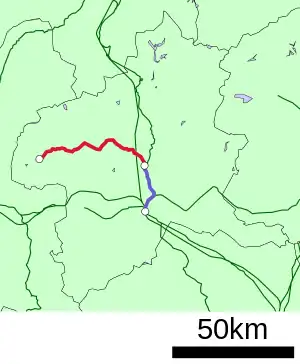| Agatsuma Line | |||
|---|---|---|---|
 A 211 series EMU, 2020 | |||
| Overview | |||
| Native name | 吾妻線 | ||
| Owner | JR East | ||
| Locale | Gunma Prefecture | ||
| Termini | |||
| Stations | 18 | ||
| Service | |||
| Type | Regional rail | ||
| History | |||
| Opened | 1945 | ||
| Technical | |||
| Line length | 55.6 km (34.5 mi) | ||
| Track gauge | 1,067 mm (3 ft 6 in) | ||
| Electrification | 1,500 V DC overhead catenary | ||
| |||
The Agatsuma Line (吾妻線, Agatsuma-sen) is a local rail line in Gunma, Japan, and is part of the East Japan Railway Company (JR East) network. Approximately following the Agatsuma River, it is 55.6 km between Shibukawa and Ōmae stations.
Operations
Although the official start of the line is at Shibukawa, all trains run through on the Jōetsu Line to/from Takasaki.
Stations

All stations are in the Gunma Prefecture.
| Station | Japanese | Distance (km) | Transfers | Location | |
|---|---|---|---|---|---|
| Between stations |
Total | ||||
| Shibukawa | 渋川 | 0.0 | Jōetsu Line (all trains through to Shin-Maebashi) | Shibukawa | |
| Kanashima | 金島 | 5.5 | 5.5 | ||
| Ubashima | 祖母島 | 2.2 | 7.7 | ||
| Onogami | 小野上 | 4.2 | 11.9 | ||
| Onogami-Onsen | 小野上温泉 | 1.8 | 13.7 | ||
| Ichishiro | 市城 | 2.3 | 16.4 | Nakanojō, Agatsuma District | |
| Nakanojō | 中之条 | 3.4 | 19.8 | ||
| Gunma-Haramachi | 群馬原町 | 3.1 | 22.9 | Higashiagatsuma, Agatsuma District | |
| Gōbara | 郷原 | 3.4 | 26.3 | ||
| Yagura | 矢倉 | 1.7 | 28.0 | ||
| Iwashima | 岩島 | 5.5 | 30.5 | ||
| Kawarayu-Onsen | 川原湯温泉 | 5.9 | 36.4 | Naganohara, Agatsuma District | |
| Naganohara-Kusatsuguchi | 長野原草津口 | 5.9 | 42.3 | ||
| Gunma-Ōtsu | 群馬大津 | 2.2 | 44.5 | ||
| Haneo | 羽根尾 | 2.2 | 46.7 | ||
| Fukurogura | 袋倉 | 2.9 | 49.6 | Tsumagoi, Agatsuma District | |
| Manza-Kazawaguchi | 万座・鹿沢口 | 2.9 | 52.5 | ||
| Ōmae | 大前 | 3.1 | 55.6 | ||
Rolling stock
Present
- 211-3000 series 4-car EMUs (since August 2016)
- E257-5000 series
- E257-5500 series
Former
- 115-1000 series 4-car EMUs (until March 2018)
- 185 series 7-car EMUs (Kusatsu limited express services until March 2014)
- 651-1000 series
Four-car 211 series EMUs entered service on the line from 22 August 2016.[1]
 A 211-3000 series EMU
A 211-3000 series EMU
History
The line opened on 2 January 1945 as the freight-only Naganohara Line (長野原線) operating between Shibukawa and Naganohara Station (長野原駅) (present-day Naganohara-Kusatsuguchi Station).[2] Passenger services were introduced as far as Nakanojō from 5 August 1945, to Iwashima from 20 November 1945, and to Naganohara-Kusatsuguchi from 20 April 1946.[2]

On 1 October 1952, the line was extended to Ōshi Station (太子駅), initially for freight only, but passengers services were also introduced from 21 June 1954.[2] Freight services between Shibukawa and Ōshi ceased as of 1 October 1966.[2]
Services on the section between Naganohara and Ōshi were suspended as of 1 November 1970, and on 7 March 1971, a new line was opened beyond Naganohara to Ōmae, with the entire line renamed Agatsuma Line at the same time.[2] The Naganohara-Kusatsuguchi to Ōshi line was formally closed as of 1 May 1971.[2] CTC signalling on the entire line was also commissioned at the same time.
With the privatization of JNR on 1 April 1987, the Agatsuma Line came under the ownership of JR East.[2]
It had been proposed to extend the line to Nagano, but geological exploratory drilling revealed extensive faulting beyond Ōmae, and as any extension would have required extensive tunnelling, this was considered impractical.
Yanba Dam construction
The Yanba Dam was proposed for construction, and required the realignment of the line between Iwashima and Naganohara-Kusatsuguchi. Construction of the diversion was well advanced when a change of government in 2009 resulted in the project being halted. Another change of government in 2012 revived the project. Services on the old section of the line were suspended following the last scheduled service on 24 September 2014 to allow commissioning of the new alignment.[3] The new alignment opened for passenger services on 1 October 2014.[3] The new route is 0.3 km shorter, resulting in the shortest tunnel in Japan, the 7m Tarusawa Tunnel, being abandoned, although it is not inundated by the new dam.[4][5]
Points of interest
The Agatsuma Line is noted for numerous onsen hot springs along the route. The famous hot springs at Kusatsu are some distance north of the line, but several rural onsen such as those at Shima, Sawatari, Kawarayu, and Shiriyaki are more accessible.
Mount Asama, Mount Kusatsu-Shirane, and the Agatsuma Canyon can all be seen from the Agatsuma Line, though the canyon will be inundated when the Yanba Dam is commissioned.
References
- ↑ 上越線・吾妻線で211系の営業運転開始 [211 series enter service on Joetsu Line and Agatsuma Line]. Japan Railfan Magazine Online (in Japanese). Japan: Koyusha Co., Ltd. 24 August 2016. Retrieved 27 August 2016.
- 1 2 3 4 5 6 7 Ishino, Tetsu, ed. (1998). 停車場変遷大辞典 国鉄・JR編 [Station Transition Directory - JNR/JR]. Vol. I. Japan: JTB. p. 105. ISBN 4-533-02980-9.
- 1 2 吾妻線新線で試運転 [Test-running starts on new Agatsuma Line section]. Japan Railfan Magazine Online (in Japanese). Japan: Koyusha Co., Ltd. 29 September 2014. Retrieved 1 October 2014.
- ↑ "Japan’s shortest railway tunnel sees its last days", AsiaOne, September 19, 2014.
- ↑ "Farewell to Japan’s shortest rail tunnel", Nippon TV, September 25, 2014 (video).
